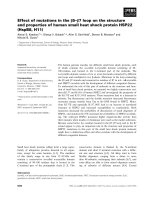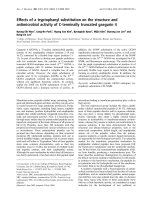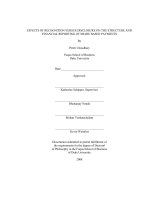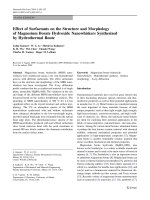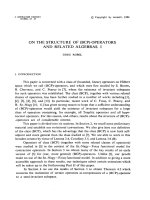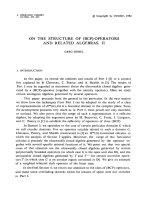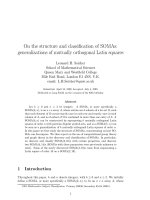On the structure and acquisition of telicity and unaccusativity in vietnamese
Bạn đang xem bản rút gọn của tài liệu. Xem và tải ngay bản đầy đủ của tài liệu tại đây (470.94 KB, 32 trang )
Taiwan Journal of Linguistics
Vol. 19.2, 1-32, 2021
DOI: 10.6519/TJL.202107_19(2).0001
ON THE STRUCTURE AND ACQUISITION OF TELICITY
AND UNACCUSATIVITY IN VIETNAMESE 1
1
Trang Phan and 2Nigel Duffield
1
VNU University of Languages and International Studies,
Vietnam National University
2
Konan University
ABSTRACT
In this paper, we investigate Chinese L2 learners’ knowledge of two grammatical
constraints in Vietnamese: the first, a constraint on the aspectual interpretation of
accomplishment predicates, the second pertaining to alternations in the position
of embedded subjects in mono-clausal làm causatives. Whereas the former
constraint is shared by Vietnamese and Chinese, the two languages differ with
respect to the latter. The results of three judgment tasks provide statistically
reliable support for the idea that L2 interlanguage grammars are not ultimately
limited by L1 patterns; given the absence of explicit teaching and only limited
exposure to relevant structures, it is suggested that learners’ performance may be
guided by UG information.
Keywords: Aspect, Causatives, Chinese, Unaccusativity, Telicity, Vietnamese
1
This research was funded by the Vietnam National Foundation for Science and
Technology Development (NAFOSTED) under grant number 602.02-2018.300 [to the
first author]. We would like to express our gratitude to the anonymous reviewers for
their helpful comments and constructive criticism of the submitted draft. We are also
extremely grateful to Nguyễn Văn Hiệp for his generous advice and support, as well as
to Wei Ku, Dongyi Lin, Man-ki Theodora Lee, and La Sieu for their expert assistance
with the Chinese data. All remaining shortcomings are our own.
1
Trang Phan; Nigel Duffield
1. INTRODUCTION
In this paper, we report on experiments investigating Chinese L2
learners’ knowledge of two grammatical constraints in Vietnamese
grammar, the first, a constraint on the aspectual interpretation of
accomplishment predicates 2, as illustrated in (1); the second, a restriction
on the kinds of predicate that can be embedded under the simple monoclausal causative verb làm, and on the position of the embedded subjects
in these constructions. Examples of the second restriction are given in (2)
and (3) below. Cross-linguistically, the former constraint is shared by
Vietnamese and Chinese; the two languages diverge, however, with
respect to the latter restriction:
(1)
a. Nó đã
ăn
cái bánh đó
nhưng chưa xong.
3S
ANT eat CLF cake that but
NEG finish
‘?? (Lit) He ate that cake, but hadn’t finished it.’
b. ??Nó đã ăn hai cái bánh nhưng chưa xong.
3S
ANT eat two CLF cake but
NEG finish
‘?? (Lit) He ate two cakes, but hadn’t finished them.’
(2)
a. ??Tôi làm thằng bé
nhảy.
1S
make CLFM little dance
‘I made the boy dance.’
b. Tơi làm
thằng bé
khóc.
1S
make
CLFM little cry
‘I made the boy cry.’
c. Tôi làm tờ
giấy rách.
1S
make CLF paper torn
‘I made the paper torn.’
2
2
Note that the first part of our study is confined to those predicates whose objects are
interpreted as incremental Themes: this includes objects that are brought into existence
(e.g., build a bridge, bake a cake), and objects that undergo a change of state (e.g.,
paint a door, sharpen a knife). See Dowty (1991).
Telicity and Unaccusativity in Vietnamese
(3)
a. *Tôi làm nhảy
thằng bé.
1S
make dance
CLFM little
‘*(Lit.) I made dance the boy.’
b. ??Tơi làm khóc thằng bé.
1S
make cry CLFM little
‘*(Lit.) I made cry the boy.’
c. Tôi làm rách tờ giấy.
1S
make torn CLF paper
‘*(Lit) I made torn the paper.’
The examples in (1) illustrate two aspectual properties of
Vietnamese. The first is that the pre-verbal aspectual morpheme đã
functions as a marker of anteriority, rather than as a perfective marker.
That is to say, đã signals only that an event or situation has begun in
advance of the reference time 3; it does not signal completion of the event
denoted. As a result – and in contrast to the English translation – there is
no incompatibility between the first clause of (1a), and the clause that
follows it (‘…but didn’t finish’); see Soh & Kuo (2005), for further
discussion. The other notable grammatical effect in (1) lies in the
contrast between examples (1a) and (1b), which differ only with respect
to the quantificational status of the object NP in the first clause: whereas
non-quantified objects, such as the demonstrative NP cái bánh đó (‘that
cake’) do not necessarily alter the (atelic) interpretation of the verbphrase, quantified objects, such as those modified by numeral quantifiers,
as in (1b), do trigger a change in interpretation: consequently, the first
clause in (1b) must be assigned a telic interpretation, leading to an
overall contradiction when followed by an assertion that the eating was
not complete.
As for the làm-causative examples in (2)–(3) above, these
exemplify two other minimal contrasts in Vietnamese grammar. The
main point to observe is that the predicate embedded under a làm
3
Unless otherwise specified, the reference time (RT) is also the utterance time (UT).
Consequently, đã is often treated as a past tense marker, even though this is a purely
accidental interpretation (in affirmative contexts). [See Phan (2013b), Duffield (2017),
Phan & Duffield (2019), for discussion].
3
Trang Phan; Nigel Duffield
causative may not be strongly unergative: 4 that is to say, it must not
assign an external thematic role to its subject argument. Example (2a)
illustrates the fact that predicates whose subject argument is interpreted
as Agent/Volitional Causer are excluded from simple làm causatives (2a);
by contrast, predicates with Inadvertent Cause (2b) and Theme (2c)
subjects are permitted to follow làm in causative constructions. These
non-agentive/ volitional subjects are further distinguished by their linear
position with respect to the lower predicate: 5 as shown by the
distributional contrasts in (3), only predicates associated with Theme
arguments permit the inverted word order in which the V2 precedes DP2;
see also Duffield (2011, 2018).
A significant point to observe here is that the thematic restrictions
only apply in ‘simple’ – that is to say, mono-clausal – causative
constructions: bi-clausal causatives introduced by làm cho, such as those
in (4), permit any kind of embedded predicate. However, as shown by
the unacceptability of the examples in (5), the inverted word order V2
DP2 is not permitted in làm cho constructions.
(4)
(5)
4
a. Tôi làm cho thằng bé
nhảy.
1S
make let
CLFM little dance
‘I made the boy dance.’
b. Tôi làm cho thằng bé
khóc.
1S
make let
CLFM little cry
‘I made the boy cry.’
c. Tơi làm cho tờ
giấy rách.
1S
make let
CLF paper torn
‘(Lit.) I made the paper torn.’
a. *Tôi làm cho nhảy
thằng bé.
1S
make let
dance
CLFM little
‘*(Lit.) I made dance the boy.’
To be more precise, làm causatives prefer weakly unergative V2s (like khóc ‘cry’) over
strongly unergatives V2 (like nhảy ‘dance’).
5 The mono-clausal vs. bi-clausal distinction between làm causatives vs. làm cho
causatives (using the diagnostics of adverbial placement, scope of negation, binding
nhau (‘each other’), a.o.) has been discussed extensively in the literature. Interested
readers are referred to Duffield (1999, 2011, 2018) and Kwon (2004).
4
Telicity and Unaccusativity in Vietnamese
b. *Tơi làm cho khóc thằng bé.
1S
make let
cry CLFM little
‘*(Lit.) I made cry the boy.’
c. ??Tôi làm cho rách tờ
giấy.
1S
make let
torn CLF paper
‘(Lit.) *I made torn the paper.’
These grammatical restrictions have been analyzed in previous
theoretical work (Duffield 2011, 2018; Phan 2013a,b). Below, we briefly
rehearse the relevant aspects of that discussion, then report the
experiments investigating the interlanguage competence of Chinese L2
learners.
2. THEORETICAL BACKGROUND
2.1 The Syntactic Representation of Aspect: ‘Outer’ vs. ‘Inner
Aspect’
In this paper, we adopt a ‘Cartographic’ approach to the projection
of grammatical features: following work by Rizzi (1997), Cinque (1999),
Cinque & Rizzi (2008) inter alia, we assume that Tense, Aspect, Mood
(Modality) and Negation are projected as independent ‘functional
categories’ in syntactic representations, according to a relatively uniform
cross-linguistic template. Most relevant to the current study is the
structural representation of two kinds of Aspect, traditionally termed
Grammatical Aspect (‘Viewpoint Aspect’) and Lexical Aspect (Smith
1997, Klein 1994, Comrie 1976, Verkuyl 1972, Travis 2010, inter alia),
respectively. As these traditional labels suggest, it was previously
assumed that Lexical Aspect referred to some inherent lexical property
that was indissociable from the predicate stem. The main justification for
this assumption came from languages such as English or French, where
this kind of semantic information is not typically morphologically
realized separately from the predicate root or stem. Indeed, in such
languages, minimal semantic contrasts between, for example activities
and achievements (e.g., look for vs. find) or between intentional vs. non-
5
Trang Phan; Nigel Duffield
directed activities and achievements (e.g., listen vs. hear) are usually
marked syncretically. In other languages however, these aspectual
contrasts are marked by more transparent and predictable morphological
alternations, either by means of affixes or through independent syntactic
elements appearing internal to the verb phrase. This type of crosslinguistic evidence suggests that it makes sense to view ‘lexical’ aspect
also as a syntactically represented functional category, albeit one that is
projected internal to the syntactic VP (close to the predicate head), rather
than within the higher (I- or C-related) functional domains.
On this approach, Lexical Aspect is viewed as a compositional
property, specifically, a compositional property of the verb-phrase, rather
than of the clause as a whole: it is expected that other lexical elements
contained within the verb-phrase, including the object NP as well as
other independently projected post-verbal particles, contribute equally to
determining aspectual interpretations. In the work of Lisa Travis,
especially Travis (2010), grammatical and lexical aspect are re-cast as
Outer and Inner Aspect, respectively: they are structurally represented as
in the phrase-marker in (6) below. We adopt Travis’ analysis in our
study.
6
Telicity and Unaccusativity in Vietnamese
(6) The Cartography of Outer and Inner Aspect (following Travis 2010)
Two inter-related properties of Vietnamese make it a particularly
interesting proving-ground for these theoretical assumptions. 6 The most
significant fact is that Vietnamese possesses an unusually large inventory
of morphologically free functional morphemes (as compared to other
isolating language varieties); these include the post-verbal particles that
are sometimes labeled ‘co-verbs’ in more traditional descriptions; see,
for example, Clark (1978), Nguyễn Đình Hồ (1997).
The other useful property of Vietnamese is its rigid (SIVO) wordorder. The fact that grammatical morphemes are free means that the
6
For more extensive discussion, see Duffield (2017), Phan (2013b).
7
Trang Phan; Nigel Duffield
underlying position of functional elements is not obscured by
morphologically driven displacements such as ‘tense-lowering’ in
English, or lexical verb-raising in French and most other Indo-European
language varieties; see Emonds (1978), Pollock (1989), Chomsky (1989).
In addition, the absence of phrasal movement means that surface wordorder in Vietnamese provides a more reliable guide to underlying
structural configurations than is the case for languages with freer word
order.
2.2 The Syntactic Representation of Cause: Intentional vs.
Inadvertent Cause
The same theoretical intuition that applies to the analysis of aspect
can be applied to the analysis of causation, namely, to reanalyze
‘syntactic’ vs. ‘lexical’ causatives in terms of ‘Outer’ vs. ‘Inner Causer’,
both being syntactically projected independently of the root predicate. In
this paper, following Duffield (2011), these two kinds of cause are
labeled Volitional Causer and Inadvertent Cause, respectively. 7
Regarding Volitional Causer, the general consensus in recent generative
literature has been that this is abstractly represented in phrase structure
autonomously from the predicate root, either as an atomic predicate
(‘little v’), or as a feature of the node so labeled: 8 see Hale & Keyser
(1993), Baker (1997), also Pustejovsky (1991), Tenny & Pustejovsky
(2000). The representational status of the second kind of cause is
somewhat more controversial. In this study, however, we will assume,
following Travis (2000, 2010), that Inadvertent Cause is a relational
property of the Inner Aspect projection in (6); that is to say, that
arguments appearing in the Specifier position of this syntactic head are
assigned this thematic relation. This assumption, which was originally
motivated by causative data from Western Malayo-Polynesian languages,
7
For the sake of terminological clarification, in this paper we assume the traditional
cause-become-state features used to describe the verbal roots (see Ramchand 2008).
Furthermore, the traditional cause feature is best decomposed into Intentional and
Inadvertent Cause, which are equivalent to Agent and Causes in Travis (2002)’s
terminology.
8 Travis (2010) refers to this node as V1: see (6) above.
8
Telicity and Unaccusativity in Vietnamese
is empirically supported by the Vietnamese contrasts in (2) and (3) above.
The full paradigm, detailed in Duffield (2011, 2018), reveals a three-way
split in the position of Volitional Causer, Inadvertent Cause, and Theme
arguments that is directly predicted by the phrase-structure template in
(6). 9 To be specific, the three types of arguments in examples (2)–(3)
occupy different positions in the structure: Volitional Causer in (Spec,
VP1), Inadvertent Cause in (Spec, AspP), and Theme in (Spec, VP2). By
hypothesis, the inverted word order in (3c) is derived through headmovement of the lexical root from V2° to Asp°:
(7) VP-internal Verb-raising in Vietnamese.
Thus, the two constructions investigated here, exemplified in (1)-(3)
above, can be understood as surface manifestations of the same
underlying phrasal architecture: in both cases, the formal properties of
the Inner Aspect projection are key to explaining the observed
constraints. 10
9
Recent alternative treatments of Inadvertent Cause include Kallulli (2006), Schäfer
(2009) and Solstad (2009).
10 See Phan (2013a, b), Duffield (2011, 2018) for independent lexical and syntactic
evidence of the projection of Inner Aspect in Vietnamese.
9
Trang Phan; Nigel Duffield
2.3 Parametric Differences between Vietnamese and Chinese
The empirical focus of the present paper is on Chinese learners’
knowledge of the aspectually related properties of Vietnamese. Our
interest in this population is motivated by the significant differences
between Chinese and Vietnamese with respect to these particular
phenomena, as a result of which Chinese learners have to do more than
simply learn some new lexical items. In spite of the typological
similarities between the two languages, Vietnamese is not a “re-lexified”
form of Chinese (or vice versa). Specifically, while the quantificational
effect of the DP object in Vietnamese is also shared by Chinese, as
illustrated in (8):
(8).
a. Ta chi-le na-ge dangao, keshi mei
chi-wan.
He eat-LE that-CLF cake,
but not
eat-finish
‘?? (Lit) He ate that cake, but hadn’t finished it.’
b. ??Ta chi-le liang-ge dangao,keshi mei
chi-wan.
He eat- LE two-CLF cake,
but not
eat-finish
‘?? (Lit) He ate two cakes, but hadn’t finished them.’
(Soh & Kuo 2005:204)
Vietnamese departs from Chinese in how the causative constraint is
realized.
In analyzing Chinese learners’ L1 settings, we adopt a distinction due
to Sybesma (1999:177–178), which postulates a contrast within the
group of causative constructions between mono-clausal ba causatives
and bi-clausal shi (‘make’) and rang (‘let’) causatives: this distinction
allows us to account for the cross-linguistic variation observed between
the two languages. 11
11
In other words, we assume Chinese ba(nong)/rang to be the direct counterparts of
Vietnamese làm/làm cho since they exhibit strikingly similar contrasts: being monoclausal or bi-clausal, and being sensitive to the unaccusative/unergative distinction or
not. Other causative forms (e.g., causative VV compounds) are excluded when claims
are made about cross-linguistic variation.
10
Telicity and Unaccusativity in Vietnamese
With respect to mono-clausal ba causatives, the VP embedded under
ba must be unaccusative (or at least weakly unergative): this is similar to
the constraint observed in Vietnamese, where Volitional Causers are
excluded in this construction – compare (9a) vs. (9b, 9c) below. Unlike
Vietnamese làm causatives, however, Chinese ba causatives totally
prohibit the inverted word order in which the embedded subjects
intervene between the causative verbs and the embedded verbs: this is
shown by the unacceptability of the examples in (10) below.
(9)
a.
b.
c.
(10)
a.
b.
c.
*Wo ba
nanhai
1S
BA
boy
‘I made the boy dance.’
Wo
ba
nanhai
1S
BA
boy
‘I made the boy cry.’
Wo
ba
zhi
1S
BA
paper
‘I made the paper torn.’
nong
do
tiaowu le. 12
dance LE
nong
do
ku
cry
le.
LE
nong
do
po
break
le
LE
*Wo ba
nong nanhai
1S
BA
do
boy
‘*(Lit) I made dance the boy.’
*Wo ba
nong nanhai
1S
BA
do
boy
‘*(Lit) I made cry the boy.’
*Wo ba
nong zhi
1S
BA
do
paper
‘*(Lit) I made torn the paper.’
tiaowu le.
dance LE
ku
cry
le.
LE
po
break
le.
LE
An anonymous reviewer draws our attention to an alternative
causative construction in Mandarin Chinese, namely nong-causatives, in
which the embedded verbs may indeed precede the embedded subject, as
in (11a). However, unlike Vietnamese làm causatives, Chinese nong
12
The Chinese examples in (9)-(12), along with grammatical judgements, were provided
by Dongyi Lin and Wei Ku.
11
Trang Phan; Nigel Duffield
causatives exclude the word order in which the embedded verbs follow
the embedded subjects, as in (11b):
(11)
a.
Wo
nong po
le
I
do
break LE
‘*(Lit) I made torn the paper.’
zhi.
paper
b.
*Wo nong zhi
po
I
do
paper break
‘I made the paper torn.’
le.
LE
Thus, a key point of variation between the two languages is that
Vietnamese (but not Chinese) allows word order alternation within one
single mono-clausal causative constructions. In particular, the embedded
subject tờ giấy (‘the paper’) can either precede or follow V2 in làm
constructions in Vietnamese, as indicated in (12a-b). On the other hand,
the two counterparts of làm constructions in Chinese have to stick either
to the pre-V2 order (as with ba constructions in (12c-d) in which zhi
(‘paper’) must precede V2), or to the post-V2 order (as with nong
constructions in (12e-f), in which zhi must follow V2), but not both. 13
(12) a. Tôi làm rách tờ
giấy.
I
make torn CLF paper
‘*(Lit.) I made torn the paper.’
b. Tôi làm tờ
giấy rách.
I
make CLF paper torn
‘I made the paper torn.’
c. *Wo ba
nong po
le
zhi.
I
BA do
break LE paper
‘*(Lit.) I made torn the paper.
13
According to our consultants, Cantonese and Yunnan Chinese behave similarly to
Mandarin Chinese with respect to this point. Therefore, the word order contrast
between Vietnamese and Chinese is still well-preserved, and the motivation for us to
choose the Sentence Matching Test in the experiments stays valid.
12
Telicity and Unaccusativity in Vietnamese
d. Wo ba
zhi nong po
le.
I
BA paper do
break LE
‘I made the paper torn.’
e. Wo nong po
le
zhi.
I
do
break LE paper
‘*(Lit.) I made torn the paper.’
f. *Wo nong zhi po
le.
I
do
paper break LE
‘I made the paper torn.’
As for the bi-clausal rang causatives, these are neither sensitive to
the unaccusative/unergative distinction, nor do they allow inverted word
order.
(13) a. Wo rang nanhai
1S
let
boy
‘I let the boy dance.’
b. Wo rang nanhai
1S
let
boy
‘I let the boy cry.’
tiaowu
dance
ku
cry
le.
LE
le.
LE
(14) a. *Wo rang tiaowu le
nanhai.
1S
let
dance
LE boy
‘*(Lit.) I let dance the boy.’
b. *Wo rang ku
le
nanhai.
1S
let
cry LE boy
‘*(Lit.) I let cry the boy.’
Here, we adopt Sybesma’s (1999:165) analysis of the internal
structure of ba causatives: we postulate for Chinese a clausal structure
that is essentially parallel to that in (7) above.
Given this, what varies cross-linguistically is the type of movement
involved: in Chinese, the head movement of V2° to Asp° is blocked
since Asp° is already filled, which leaves only one option, namely A-
13
Trang Phan; Nigel Duffield
movement of the embedded subject from {Spec, VP2} to {Spec, AspP},
resulting in the correct surface word order. 14
(15) VP-internal Object-raising in Chinese.
The distributional consequence of this difference is that Chinese
never shows the word order alternation observed in Vietnamese in
mono-clausal causative constructions by which the embedded subjects
can either precede or follow the embedded verbs.
To sum up, among several aspect-related properties shared by, or
distinguishing Vietnamese and Chinese, we have selected for
experimental investigation two kinds of subtle grammatical constraints
to investigate experimentally: (i), a constraint on the interpretation of
telicity triggered by particular kinds of object noun-phrase in perfect
sentences; (ii), a constraint on the placement of the arguments of
unaccusative vs. unergative predicates embedded under the simple
causative verb làm. The former constraint is shared by Vietnamese and
Chinese, while the latter distinguishes the two grammars.
14
See Sybesma (1999: Chapter 6) for extensive supporting evidence.
14
Telicity and Unaccusativity in Vietnamese
The experiments outlined in the next section were designed to test
whether Chinese L2 learners of Vietnamese are sensitive to the subtle
variations among these different causative constructions, such that they
can give target-like judgments concerning restrictions that are never
explicitly taught in Vietnamese L2 classrooms (to our knowledge). The
logic of this approach should be clear: if learners’ judgments of the
acceptability (or otherwise) of minimal grammatical contrasts, such as
those in (1)-(3), can be shown to converge on those of native-speakers,
in the absence of explicit instruction and where L1 ‘transfer’ is not a
possible explanation, then it is plausible to conclude that L2 learners’
grammar acquisition is guided by knowledge of universal syntactic
principles, including the specific cartographic knowledge discussed
above (knowledge of Inner Aspect, and of the position of Inadvertent
Cause. See White (2003), Schwartz & Sprouse (1996), for more general
arguments. 15
Our experiments also bear on a more specific issue within generative
approaches to second language acquisition regarding] the acquisition of
parametric features: whether second language learners’ access to UG
constraints is ‘partial’ – restricted to those properties instantiated in their
L1 or ‘full’, in the limit; compare Tsimpli & Roussou (1991), Hawkins
& Chan 1997) with work by White (2003), Schwartz & Sprouse (1996),
Gabriele (2009), and Nossalik (2014). Although both approaches agree
that initially, L2 learners fully transfer properties of the L1 grammar,
they make different predictions as to learners’ proficiency. When L2
learners encounter functional features from the L2 that do not match
their L1, the Partial Access Hypothesis predicts that L2 learners may
superficially use the L2 form but with the underlying functional features
of their L1. Full Access theories, on the other hand, predict that interlanguage grammars are not ultimately limited by L1 functional features,
15
We do not discount the possibility of alternative explanations for learners’ knowledge,
for example, Emergentist accounts (e.g., MacWhinney 2004, 2006). The experiment is
couched in generativist terms, since that is the theory used for our grammatical
description. However, our results are consistent with any theory that allows for
learners to go beyond the input in systematic ways that are not dictated by their L1.
15
Trang Phan; Nigel Duffield
and that L2 learners can indeed attain native-like knowledge of target
grammar features. We discuss below whether the findings of our study
provide evidence in support of one or other of these hypotheses.
3. EXPERIMENTS
3.1 Participants
Our experiments involved 36 native-speakers of Vietnamese,
together with 82 Chinese-speaking L2 learners (45 advanced, 37
intermediate). The participants, aged between 18 and 22 years old, were
recruited in Hanoi (Vietnam National University), where they were
studying on undergraduate courses at that time. All of the L2 learners
had been first exposed to Vietnamese in a formal university classroom
setting; at the time of testing, they had spent nine months in Vietnam as
exchange students. All were classified as adult learners of Vietnamese 16.
The Chinese L2 learners were divided into intermediate and
advanced groups based on the results of an independent proficiency test.
The proficiency test consisted of 50 multiple-choice sentences, which
mainly focused on grammatical properties of Vietnamese sentences such
as discourse-related elements (thì, mà, là, rằng), pre-verbal tense, aspect,
and modality markers (đã, đang, sẽ, khơng/chưa, có, bị, được, nên), the
post-verbal elements (xong, hết, cả, rồi), as well as NP-related functional
morphemes. Advanced proficiency was indicated by a score of > 40
16
In fact, Vietnamese was not strictly the second language of the participants: the
participants were already speakers of Cantonese and Yunnan Chinese, in addition to
Mandarin Chinese. They were also learning English as a foreign language at school,
though their English knowledge of English was only at a rudimentary level. This was
not considered to be a problem, given that Cantonese and Yunnan Chinese resemble
Mandarin Chinese with respect to our linguistic phenomena under investigation. Nor
was their knowledge of English of any help to them either since English diverges even
more sharply from Vietnamese with respect to the properties under investigation. For
the sake of simplicity, however, we still refer to the Chinese learners of Vietnamese as
L2 learners. We are grateful to Dongyi Lin and Wei Ku for the judgments on
Mandarin Chinese], to Man-ki Theodora Lee for those on Cantonese, and to La Sieu
for those on Yunnan Chinese.
16
Telicity and Unaccusativity in Vietnamese
correct answers; participants scoring from 27 to 40 correct were
classified as intermediate. Participants whose scores fell below 27 in the
proficiency test were excluded from the experiment.
The control group consisted of ‘non-linguists’ that is to say, nativespeakers without any linguistic training, none of whom had spent more
than three months abroad. Participants were not paid for their
participation, but received additional course credits in their final course
evaluation.
3.2 Methodology: Materials and Design
Three tasks were used: a pen-and-paper Interpretation Test, which
investigated knowledge of the aspectual interpretation contributed by
object noun-phrases; a computer-based Sentence Matching Task (SMT),
which tested participants’ sensitivity to the unaccusative vs. unergative
contrasts found in causative constructions, as well as a standard off-line
acceptability judgment task (AJT), to confirm the validity of the SMT.
Task 1 (Interpretation Test)
In the first task, the participants were given a written questionnaire
which required them to determine the truth of certain sentences in
particular contexts of utterance. For example, they were asked (in
Vietnamese) questions about the interpretation of sentences containing
đã plus either a non-quantificational or quantificational object NP;
compare (16a) vs. (16b): 17
(16) a.
17
If it is reported that ‘Nó đã ăn cái bánh đó’ (He ate that cake),
is there any possibility that he has not finished that cake? Yes
or No. [Condition 1: in this case, the expected answer is Yes.]
The stimulus sentences were organized in a Latin Square design such that each
participant received either the (a) or (b) version of any given test question, and all
participants received equal numbers of true and false sentences. The test also included
a set of distractor items in which the anterior morpheme đã was replaced by either the
progressive morpheme đang or the future/irrealis morpheme sẽ; in both cases, the
expected answer was ‘No’.
17
Trang Phan; Nigel Duffield
b.
If it is reported that ‘Nó đã ăn hai cái bánh’ (He ate two
cakes), is there any possibility that he has not finished the
second cake? Yes or No. [Condition 2: here, the expected
answer is No.]
Each participant was requested to answer 64 questions, consisting of
32 test sentences and 32 distractor items. Two versions of the materials
were prepared, each with a different set of 32 lexical predicates.
Participants were alternately assigned one or other version of the task. In
this task, the independent between-item variables were thus Condition
and Version. The independent between-subject variable was Proficiency:
Native-speaker vs. Advanced Learner vs. Intermediate Learner. The
dependent measure in the task was the proportion of acceptances;
alternatively, the proportion of correct answers (correct acceptances or
rejections); see below.
Task 2 (Sentence matching task - SMT)
In the computer-based Sentence Matching Task, participants are
asked to judge whether two sentences, presented consecutively on a
computer screen, are identical in form (“match”) or not (“mismatch”).
The theoretical value of this paradigm resides in the fact – originally
demonstrated in Freedman & Forster (1985), and often replicated since –
that identical grammatical sentences are matched by native speakers
reliably more quickly than identical ungrammatical sentences (typical
mean difference 30-60msecs). 18 Hence, reliably faster response latencies
provide an implicit index of grammaticality. 19 If L2 learners show a
similar pattern of response latencies to those of native-speakers – even if
their overall reaction times are slower – then it is reasonable to conclude
that they possess a similar grammatical competence with respect to the
phenomena under consideration.
18
See Duffield & White (1999), Duffield, White et al. (2002). It should be noted that not
everyone accepts the validity of the SMT as a measure of grammatical competence –
or indeed the basic interpretation of the main effect: see Crain & Steedman (1985) for
an early challenge; for a rejoinder, see Duffield, Matsuo & Roberts (2007).
19 Non-matching items are foils in the experiment: the only comparison of interest is the
contrast between matching grammatical vs. matching ungrammatical items.
18
Telicity and Unaccusativity in Vietnamese
The SMT investigated learners’ sensitivity to the grammatical
acceptability of six different sentence types. Relative acceptability was
modulated by three main factors: unaccusativity (unaccusative vs.
unergative predicates); invertedness (canonical SV vs. VS order); the
presence of an additional causative verb cho (‘give, let’). The conditions
are listed and illustrated in the following table:
Table 1. SMT – Construction Types tested
Type
Construction
Grammatical
acceptability
A
Non-inverted
?Less
acceptable
unaccusative
than B, though still
grammatical
B
Inverted
Strongly acceptable
unaccusative
C
Inverted
*Strongly
unergative
unacceptable
D
Non-inverted
??Not
ungrammatical but
unergative
less
preferable
(than E)
E
làm cho Non- Clearly acceptable
inverted
unergative
F
làm cho Inverted *Clearly
unaccusative
unacceptable
Example
?Tôi làm tờ giấy rách
(I made the paper torn)
Tôi làm rách tờ giấy
(I made torn the paper)
*Tôi làm nhảy thằng bé
(I made dance the boy)
??Tôi làm thằng bé
nhảy. 20
(I made the boy dance)
Tôi làm cho thằng bé
nhảy.
(I make let the boy run)
*Tôi làm cho rách tờ
giấy (I make let torn
the paper)
The SMT consisted of 60 pairs of test sentences (ten pairs per
sentence type), which were all matching pairs, either grammatical or
ungrammatical; and 60 pairs of mismatching distractor sentences, which
involved làm or cho in their non-causative usages (i.e., when làm means
‘to do’, ‘to work as’, ‘to make’, etc.; where cho is used as a main
predicate which means ‘to allow’, ‘to let’, ‘to give’; or as a preposition,
20
Sentences of Type D are only acceptable with an inadvertent reading.
19
Trang Phan; Nigel Duffield
etc.). There were two versions of the SMT, each involving a different set
of 60 lexical predicates.
Note that the tested constructions in Table 1 can be clustered into
three groups in terms of grammatical acceptability: Constructions B and
E are grammatically acceptable, Constructions A and D are ‘marginal’,
and Constructions C and F are grammatically unacceptable. Among
these constructions, Construction B is the crucial condition from the
point of view of cross-linguistic variation, since the word order presented
in Construction B is strongly acceptable in Vietnamese but unacceptable
in Chinese.
Procedure. The experiment was run on PCs using DmDX display
software (Forster, K. I. & Forster, J. C, 2003). A brief instruction
paragraph was first displayed in Vietnamese; this was then followed by 8
eight practice trials (half involving matching, half non-matching pairs).
The first sentence of each pair was offset towards the top left of the
screen and then disappeared. After a delay of 2000msecs, the second
sentence was presented towards the bottom right of the screen. A timer
started at the onset of the second sentence and was stopped when the
participant pressed one of the two SHIFT buttons: the right SHIFT if
they considered the pair to be identically matched; the left SHIFT if they
detected a mismatch. Each trial was timed out if the subject did not
respond within 3500msecs of the presentation of the second sentence.
The next trial appeared after an interval of 700msecs (ISI). The task
included three breaks, which occurred after every 30 trials: participants
could decide when to resume, by pressing the spacebar. All of the items
were randomized for each participant. It took around 20-30 minutes for
each participant to complete the task.
In the SMT, the independent variables (between-items were Sentence
Type (A-F), Grammatical Acceptability (good, marginal, unacceptable),
Unaccusativity (unaccusative vs. unergative) and Version (two levels);
the between-subjects variable was Proficiency (native-speaker vs.
advanced vs. intermediate learner). The dependent measure was the
response latency in each trial.
20
Telicity and Unaccusativity in Vietnamese
Task 3 (Acceptability judgment task – AJT)
The SMT was immediately followed up by an Acceptability
Judgment Task, which also tested the same six sentence types, and
involved the same set of 60 test sentences. There were also 60 distractor
sentences, which were the first sentences of the mismatching pairs in the
SMT. As with the SMT, the AJT consisted of two versions: the
participants that took version A in the SMT received version B in the
AJT, and vice versa.
Scoring. Participants were asked to judge the acceptability of each
sentence according to a seven-point Likert scale (from -3 totally
unacceptable, to +3 fully acceptable). For any sentence assigned a
negative score, participants were requested to provide written corrections.
Hence, there were two dependent measures in this task: the acceptability
score for each item, a quantitative measure, and the type of correction
offered for negatively scored items, a qualitative measure. Once again,
the participants took about 20 to 30 minutes to judge the acceptability
and make corrections to all of the sentences.
3.3 Results and Discussion
Task 1 (Interpretation Test)
Overall, both non-native proficiency groups performed reasonably
well in this task, their results generally conforming to those of the nativespeaker control group: the mean correctness across the L2 groups was μ
= 71.07%, SD σ= 12.62%). An Analysis of Variance revealed a reliable
main effect of Condition (p < 0.05) and of Proficiency (p <0.05), as
expected. Also as expected, there was no main effect of version (p =
0.108). No reliable interactions were observed between Condition and
Proficiency: i.e., all of the proficiency groups responded to each
condition in much the same way.
Let us consider now the results by condition. As noted above, the
comparison of greatest interest was that between Condition 1 and
21
Trang Phan; Nigel Duffield
Condition 2, where a clear contrast was predicted. As indicated in Fig. 1
below, this prediction was borne out: the figure also shows that both
groups of L2 learners show a very similar pattern to that of the nativespeaker control group, clearly suggesting their awareness of the
difference between the two constructions (demonstrative objects vs.
numeral objects) with respect to entailment of completion.
Figure 1. Interpretation Test: Mean scores by condition
The result was as expected: all participants gave low acceptance scores
(= ‘No’ responses) in Condition 1, high acceptance scores (= ‘Yes’
responses) in Condition 2.
Task 2 (Sentence matching task - SMT)
In this task, the overall prediction was that the matching of
grammatical sentences should elicit shorter response latencies than the
22
Telicity and Unaccusativity in Vietnamese
matching of ungrammatical pairs, and that more advanced learners and
native-speakers should respond faster than intermediate learners. Across
the data, these general predictions were borne out: an ANOVA revealed
a main effect of Grammaticality (p < 0.05), together with main effects of
Proficiency (p <0.05) and Unaccusativity (p = 0.001) (all one-tailed).
Figure 2. SMT: Effects of Proficiency and Grammaticality
Fig. 2 once again reveals a very similar pattern among the three groups.
All of the participants were able to distinguish reliably between
grammatically acceptable, marginal and grammatically unacceptable
sentences. Unsurprisingly, the native-speakers’ responses were generally
faster than those of the learner groups.
Looking more closely by Construction Type, the results show a more
complex pattern. In both Figs. 3 and 4 below, Construction Types are
ordered from left to right in terms of decreasing grammatical
acceptability: overall, what was predicted was a pattern of step-wise
increasing or decreasing values {B/E > A/D > F/C}, increasing in the
case of response latencies (Fig. 3), decreasing with respect to
23
Trang Phan; Nigel Duffield
acceptability judgment scores (Fig. 4). This prediction was mostly borne
out:
Figure 3. SMT: Response Latencies by Construction Type and
Proficiency
Interestingly, in spite of cross-linguistic variation in their L1
grammars, Construction B elicited the fastest response from both native
speakers and advanced learners (though not from the intermediate
learners) in the SMT.
However, what remains problematic in the SMT results is that
Construction C, which was judged unacceptable offline, elicited faster
than average responses from all participant groups. This requires further
discussion.
Task 3 (Acceptability judgment task – AJT)
As expected, statistical tests reveal a significant main effect of
Construction Type (p< 0.05), but no effect of Version in the AJT.
Although no main effect of Proficiency was observed, a marginal
interaction was found between Construction Type and Proficiency (p =
24
Telicity and Unaccusativity in Vietnamese
0.05). The results are presented in Fig. 4, by Construction Type and
Proficiency:
Figure 4. Acceptability Judgment Task: Scores by Construction Type
and Proficiency
Native speakers are shown to correctly accept grammatical sentences
(with the highest scores in Construction Types B and E) and to reject
ungrammatical sentences (with the lowest scores in sentences type
Construction Types F and C). Advanced learners show much the same
pattern of judgment; however, the scores of the intermediate group are
considerably more variable.
Significantly, in spite of the cross-linguistic variation, construction
Construction B was scored the highest by both native-speakers and the
advanced learners (but not by the intermediate learners, while
construction C received the lowest scores from all groups. There was
thus a clear discrepancy in this condition between the SMT and AJT
results.
25

